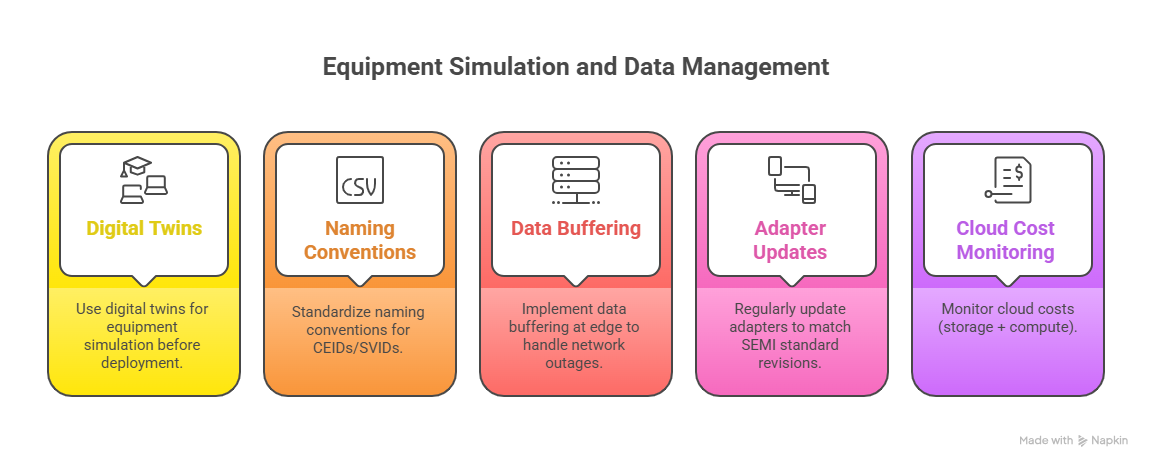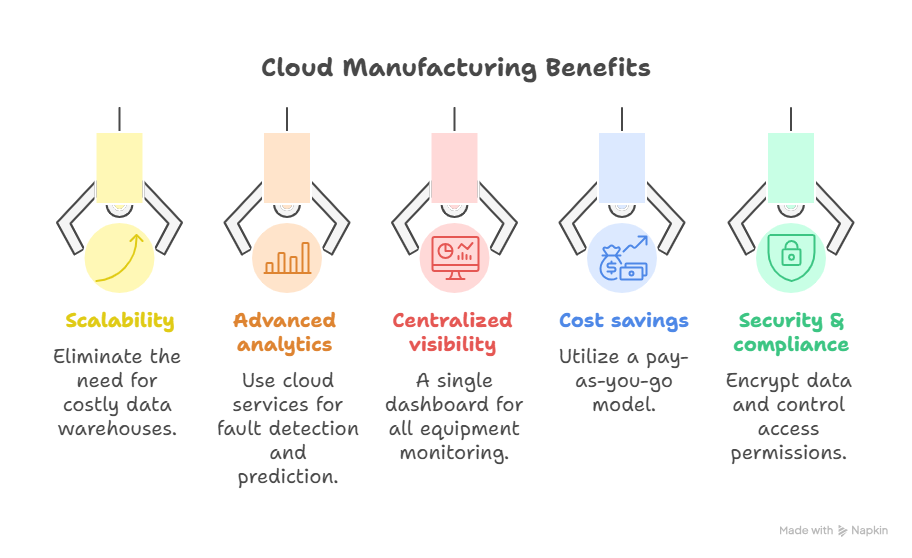Introduction
The semiconductor industry is undergoing a digital transformation, driven by the need for real-time analytics, predictive maintenance, and global visibility. At the core of this evolution lies SECS/GEM integration, a standard that enables semiconductor equipment to communicate seamlessly with factory systems. Traditionally, SECS/GEM has been used for on-premise automation, but the rise of cloud platforms such as AWS, Azure, and Google Cloud has created new opportunities.
By enabling SECS GEM cloud integration, manufacturers can scale data processing, leverage advanced AI/ML capabilities, and gain centralized monitoring across fabs. This article provides a step-by-step approach to achieving HSMS SS to cloud / SECS-II to cloud connectivity, ensuring smooth semiconductor equipment cloud connectivity for future-ready factory automation.

Step 1: Understand SECS/GEM and Its Relevance
SECS/GEM, defined by the SEMI E30 standard, is a widely adopted communication protocol in semiconductor fabs. It allows tools to send events, alarms, and process data to a host system, while also supporting commands such as recipe downloads and trace data collection. In today’s digital era, Factory automation cloud integration extends these capabilities beyond local MES systems to global, cloud-based infrastructures.
The shift is particularly important for MES integration SECS/GEM, where Manufacturing Execution Systems need real-time insights across multiple fabs. By connecting SECS/GEM directly to cloud environments, companies can achieve predictive analytics, centralized yield management, and secure global monitoring.
Step 2: Choose Your Cloud Platform and Architecture
The most common path to the cloud is through SECS/GEM AWS integration. AWS provides services like IoT Core, Kinesis, S3, and Lambda that can handle streaming data, storage, and real-time event processing. For example, an adapter can bridge HSMS to AWS IoT Core, enabling equipment data to flow securely into AWS. Once ingested, developers can route SECS-II to AWS Lambda for on-demand processing or stream GEM to Amazon Kinesis / S3 for long-term storage and advanced analytics.
Similarly, Azure and Google Cloud provide equivalents such as IoT Hub, Event Hubs, and Pub/Sub. Regardless of the platform, the goal remains the same—enable reliable semiconductor equipment cloud connectivity.

Step 3: Deploy an Edge Gateway or Adapter
Direct equipment-to-cloud connectivity is often impractical due to network and security limitations. Instead, an edge gateway converts HSMS SS to cloud / SECS-II to cloud messages into lightweight formats like JSON, MQTT, or Kafka. These gateways ensure secure encryption, message buffering, and local failover.
For fabs that already rely on MES, MES integration SECS/GEM through cloud gateways allows both on-premise and remote systems to access the same data. This hybrid approach supports gradual migration to the cloud while maintaining compliance with SEMI standards.
Step 4: Build the Cloud Data Pipeline
Once data is flowing, the next step is building a robust data pipeline. On AWS, HSMS to AWS IoT Core serves as the ingestion layer, while SECS-II to AWS Lambda performs transformations and routing. Historical data can be stored in Amazon S3, while real-time traces and alarms are streamed via GEM to Amazon Kinesis.
This architecture not only supports Factory automation on AWS, but also prepares fabs for AI-driven insights. Cloud-native services like SageMaker (AWS) or Azure Machine Learning can analyze SVID traces for predictive maintenance, yield optimization, and root-cause analysis. For advanced fabs, SEMI EDA on AWS extends integration further by combining SECS/GEM with richer Interface A standards for high-volume data collection.
Step 5: Enable Analytics, Visualization, and Security
With the pipeline in place, engineers can build dashboards for semiconductor equipment cloud connectivity using tools like Grafana, Power BI, or Tableau. Alarms and events can be visualized in real time, while historical data is mined for yield insights. Security is equally important: VPN tunnels, TLS encryption, and role-based access ensure compliance with SEMI security guidelines.
Following these practices ensures that Factory automation cloud integration is both reliable and secure.
SECS/GEM integration with cloud platforms represents a major leap forward for semiconductor fabs. By following a structured approach—assessing equipment, deploying gateways, building data pipelines, and enabling analytics—manufacturers can achieve robust SECS GEM cloud integration.
Whether through HSMS SS to cloud / SECS-II to cloud or hybrid models, fabs can ensure seamless semiconductor equipment cloud connectivity. With the flexibility of SECS/GEM AWS integration, services like HSMS to AWS IoT Core, SECS-II to AWS Lambda, and GEM to Amazon Kinesis / S3 unlock scalable architectures for Factory automation on AWS. The future extends further with SEMI EDA on AWS, offering richer data and advanced analytics.
By moving SECS/GEM data to the cloud, fabs can transform their operations—gaining real-time visibility, predictive maintenance, and AI-driven optimization. Cloud-connected automation is no longer optional; it is the foundation of competitive semiconductor manufacturing.

